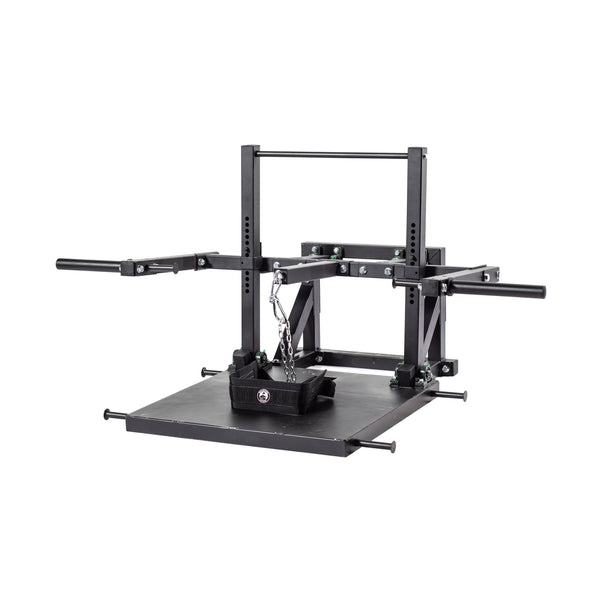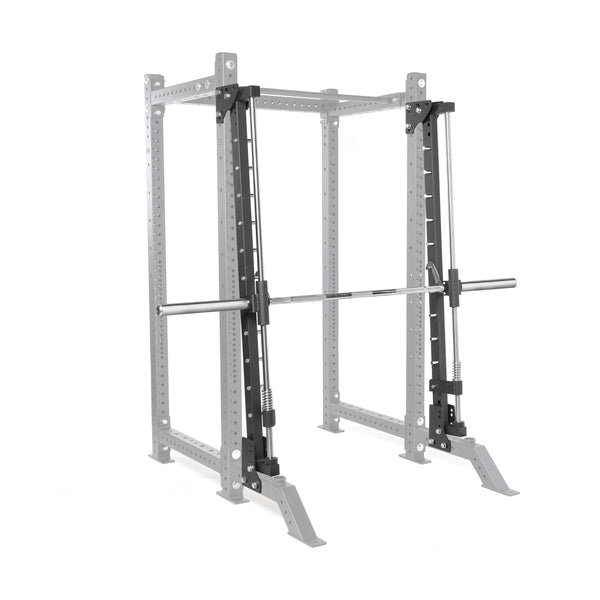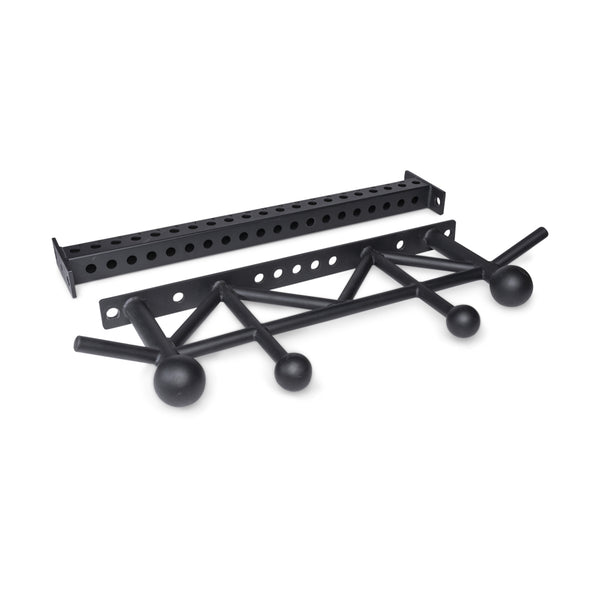Building lower-body strength is a cornerstone of effective strength training, and squat machines offer a versatile, joint-friendly, and sometimes space-efficient way to get there. Whether you're outfitting a home gym or supplementing your barbell training, understanding the different types of squat machines can help you choose the right tool for your goals.
This guide covers the most common squat machines: including the Smith machine, hack squat machine, belt squat machine, and the pendulum squat machine (coming soon to more home gym setups). We’ll break down the pros and cons of each so you can squat smarter, not just harder.
Types of Squat Machines and Their Benefits
Smith Machine: A Guided Path to Strength
The Smith machine features a barbell fixed to vertical rails, allowing for straight up-and-down movement. It removes the need to stabilize the bar, making it an excellent tool for beginners or for isolating specific muscle groups under load.
Pros:
-
Great for beginners learning squat mechanics
-
Removes stabilizing demand, reducing risk of form breakdown
-
Allows for high reps with less fatigue from balancing the bar
-
Can be used for multiple exercises beyond squats
Cons:
-
Doesn’t mimic natural squat mechanics
-
Can overemphasize quads if not properly positioned
-
Not ideal for training functional movement patterns
Hack Squat Machine: Quad Domination
The hack squat machine puts you at an angle, with your back supported and shoulders under pads, letting you focus entirely on your lower body. It's quad-heavy but also hits the glutes and hamstrings depending on foot placement.
Pros:
-
Extremely effective for isolating the quads
-
Safer alternative for those with limited mobility
-
Back support reduces spinal compression
-
Great for hypertrophy-focused training
Cons:
-
Large footprint for most home gyms
-
Can limit range of motion based on machine design
-
Less glute/hamstring activation compared to other squat variations
Pendulum Squat Machine: The Smooth Operator
The pendulum squat (soon to hit more home gyms) offers a hybrid approach. With a swinging arm and a natural arc of movement, it encourages deep squats with more joint-friendly mechanics.
Pros:
-
Smooth, joint-friendly movement pattern
-
Allows for deep squats with minimal back strain
-
Highly effective for quad, glute, and hamstring engagement
-
Great for advanced lifters chasing leg growth
Cons:
-
Not yet widely available for home gym setups
-
Requires more space and investment than simpler machines
-
Limited versatility—primarily for squats
Belt Squat Machine: Heavy Lifting, Spine-Free
The belt squat machine lets you load your lower body without putting a bar on your back. The load is attached to a belt around your waist, minimizing spinal compression while still training heavy.
Pros:
-
Ideal for lifters with back, shoulder, or wrist issues
-
Great for high-volume squat training with less fatigue
-
Highly versatile—can be used for marches, rows, and more
-
Easier to recover from compared to barbell squats
Cons:
-
Can feel awkward to set up initially
-
Requires platform, elevated surface, or space
-
Some machines have limited range of motion depending on design
Choosing the Right Squat Machine
What’s best for hypertrophy?
If your goal is muscle growth, the hack squat and pendulum squat machines take the crown. They isolate the quads and allow for progressive overload without taxing the back or balance too heavily.
What’s best for injury recovery or joint health?
The belt squat is the top choice here. It allows you to train your legs hard without loading the spine, making it a game-changer for injured or aging lifters.
What’s best for home gyms?
If space is tight, a Smith machine with multiple exercise functions may be the most practical. But if you’re short on space and want versatility, modular machines or belt squat attachments can help you get squat variation without the bulk.
Frequently Asked Questions About Squat Machines
Are squat machines better than barbell squats?
Not necessarily better; just different. Squat machines reduce the need for balance and often allow for higher training volume with lower fatigue. However, they don’t train stabilizing muscles like barbell squats do. The best approach is to use both.
Can beginners use squat machines?
Absolutely. Machines like the Smith machine or hack squat offer a safe introduction to squat movement patterns without the complexity of free weights. They help build confidence while developing strength.
Do squat machines help with muscle growth?
Yes. Squat machines are fantastic for hypertrophy. By removing balance and stabilization demands, they allow lifters to push their muscles to failure with less risk of form breakdown.
Which squat machine is best for bad knees?
The pendulum squat and belt squat machines are generally easier on the knees. Both offer smoother movement patterns and let you adjust foot positioning to reduce joint stress. Always talk to your health care provider before engaging in new movements.
Can I replace barbell squats with squat machines?
You can, especially if you're training for general strength or hypertrophy rather than competition. However, barbell squats train coordination, balance, and total-body strength in a way that machines can’t fully replicate.
Final Thoughts
Squat machines can be a powerful addition to your training toolkit, especially in a home gym. Whether you're managing injuries, chasing hypertrophy, or simply working with limited space, there's a squat machine that fits your goals. From the smooth path of the pendulum squat to the spine-saving benefits of the belt squat, it's never been easier to build strong legs with smart equipment choices.






